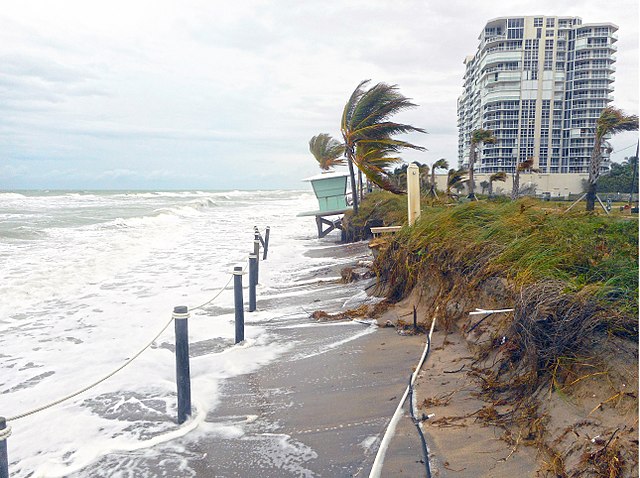The Dynamic Coastline and Human Uses

While maps typically delineate the transitions between land and sea with clear lines, in reality, the coastline is much less well-defined. The position of the coastline through time is highly variable, from the daily fluctuations of the water’s edge at beaches due to tides to the shoreline advance or retreat over hundreds of kilometers with geologic-scale or climatic influenced sea level fluctuations. As you read in the ConScience article, the coastline position does not just depend on sea level; instead, the supply of sediments to the coast and the processes responsible for their redistribution within a coastal cell are both responsible for coastal evolution. Coastal erosion removes material from the shoreline and redistributes it to other parts of the coastal cell. While erosion is usually most drastic during extreme events with associated high surges and waves, shoreline erosion can also occur gradually over a longer time period due to sediment deficits.
In modern times (decadal timescales), many of the world’s coastlines are characterized by erosion (approximately 70% of the world’s sandy coastlines are retreating). This widespread erosion is due to a variety of factors, most notably:
- global eustatic sea level rise that has occurred over the past century;
- global reductions in the supply of sediment reaching the coast (due to sediment impoundment behind dams, urbanization, etc.);
- human engineering at the coast that restrict sediment movement (harbors, seawalls, groins).
Coastal erosion is a naturally occurring process that can be exacerbated and becomes a significant problem when the dynamic coastline impinges on the fixed human infrastructure and uses within the coastal zone. Despite the potential risk of coastal erosion or flooding within the coastal zone, the majority of the world’s human population resides there, and in fact, numbers continue to grow as people migrate to coastal cities. Coasts continue to support the economic centers of the world, while at the same time critically ecologically important and sensitive natural habitats are supported by coastal zones. Coastal zones support a wide variety of human land uses. Tourist resorts, fishing communities, farming, aquaculture, and other land uses all vie for space on the coasts of the world, and often come into conflict with each other and with the dynamic interface between land and water. While inland areas are undoubtedly less vulnerable to coastal hazards, the coastal zone has been historically rich in resources and uniquely suited to support economic activities such as trade, industry, and tourism, attracting settlement and migration despite the elevated risks.
The primary impact of human activities within the coastal zone is the displacement of natural habitat with development, an increasing problem with continued coastal population growth. This issue will be examined in detail in Module 11 case studies. In the following pages, we will examine more closely the mechanics of coastal erosion and the human engineering strategies employed around the world to mitigate coastal erosion to sustain human land uses on the coast. We will question each approach in terms of sustainability in the context of the dynamics of the coastal zone and the increased challenges related to climate change.
These land use change maps of Egypt's Nile Delta, which are shown in the link below, show change over 24 years, between 1990 and 2014. Comparison of the two maps reveals many changes to the land-water interface on this coast. As you compare the two images, you will notice that the human activities that impact the coastline, such as fish farming and urban areas increase in area. The area of natural coastal lands decreases in area. Almost all urbanized coastal zones around the world will show complex land use changes such as these over the past few decades.
